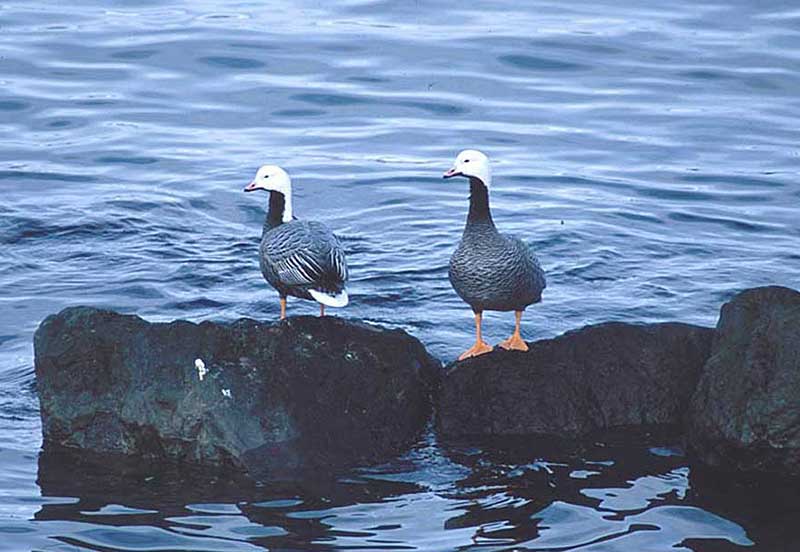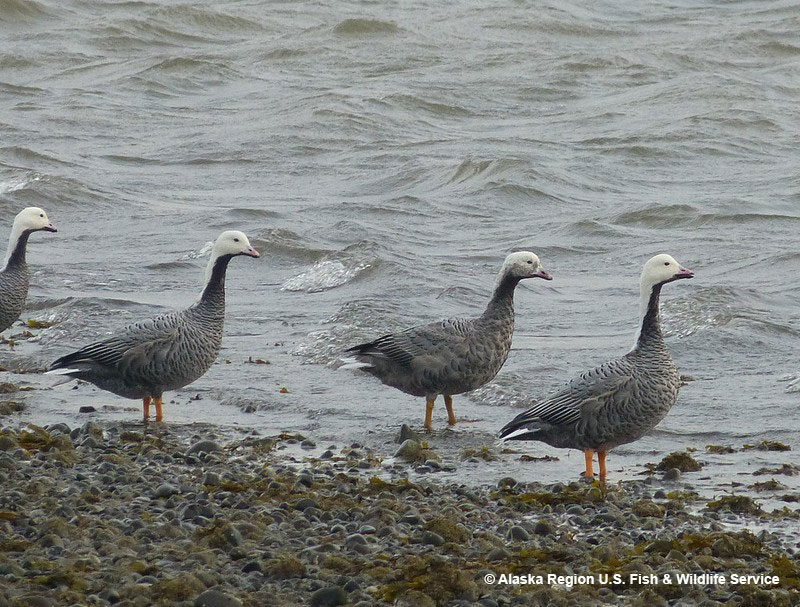The Emperor Goose is a species of goose that is most commonly found along the Bering Sea and is known for its unique plumage, which includes a white head, black throat, and a body delicately patterned in bluish-gray and black.
These birds are known for their hardiness, as they are able to survive in some of the coldest environments on earth, however, their population has been in decline due to a number of other reasons.
Identification
Emperor Goose is small for a goose, measuring on average 27 inches in length and weighing around 6-7 pounds. The male and female look the same, the only difference being that the male Emperor Goose may be slightly heavier than the female.
Emperor Geese are covered in a bluish-gray plumage that is barred with black and white, their chin and throat are black, and their head, back of the neck, and tail feathers are white.
Their white head can also be lightly rust-colored if they feed in iron-rich substrates. They have a relatively short light pink bill and orange feet.
The goslings and juveniles are covered in gray feathers all over, including the head, and have a black beak. Immature Emperor Geese look like adults but have black or gray specks on their face and head.
Emperor Geese vocalize less than other species of geese and have only two types of calls that sound nasal. The first one you can hear if the bird feels threatened, making a u-lugh u-lugh sound that can be accompanied by hissing. The second one sounds like kla-ha kla-ha and can be heard during migration when birds flock together in large numbers.
Food
Emperor Geese are mainly herbivores, but also feed on marine invertebrates. On breeding grounds and during summer, they forage mostly on land, digging in the soil for roots or grazing on shoots of grasses and sedges.
They consume a variety of plants including beach rye, beach pea, seabeach sandwort, sedges, eelgrass, marine algae but also berries, such as black crowberries and blueberries.
During winter and migration, however, they add macoma clams, blue mussels, and invertebrates to their diet. They can be seen walking and foraging on mudflats that have been exposed by retreating tides, where they stomp their feet to create a pool and then eat the clams they find. They can also submerge their head underwater to find invertebrates.
Goslings get almost the entire needed protein for growth from plants and when possible, choose protein-rich plants to feed on, preferring marsh arrowgrass when it’s available.
Nesting and Eggs
Emperor Geese are monogamous and pair bond for life, only choosing another mate if the previous one dies. There isn’t much information about how the pairs are formed or how breeding occurs, but it seems to happen during or before migration, before arriving on breeding grounds.
The female Emperor Goose chooses the nest site, which is usually surrounded by low dead vegetation that still offers good visibility. The nests can be found on islands on shorelines, raised hummocks, ponds, or at the edge of a river.
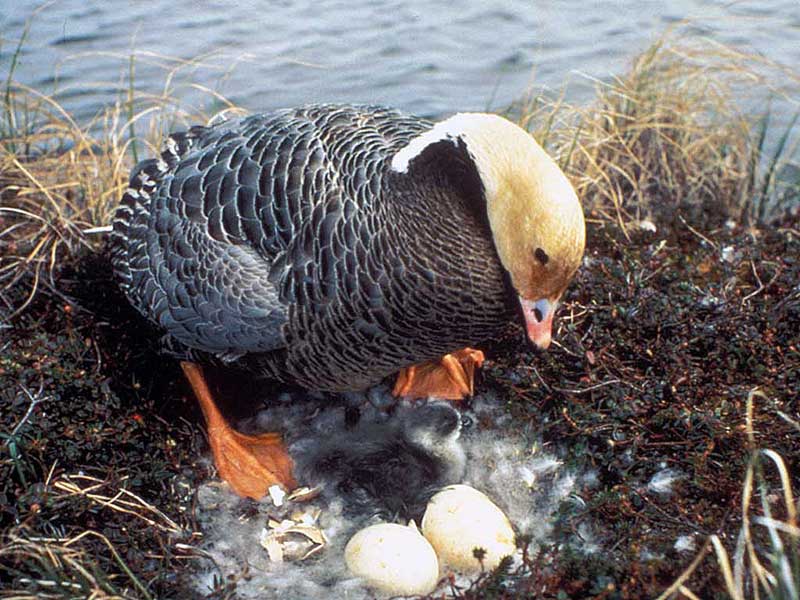
The female then starts building a nest, first digging a shallow scrape in the ground, then lays the first egg and continues building the nest from vegetation around the nest and her own down feathers while laying more eggs. The nest is on average 14.8 inches across, the interior cup being 3.2 inches deep and 7.8 across.
The female lays 2-8, on average 4-6 creamy or dull white eggs, which they can also lay in other females’ nests, even though the parents guard their nests dearly. The mother bird incubates the eggs alone for 24-27 days.
The goslings leave the nest in less than a day, following their parents to feeding areas either by swimming or walking. They are fully feathered at 30-47 days and able to fly about 50-60 days after hatching.
The young remain close to their parents during the first winter and return to the same breeding ground they grew up in, although they don’t mate until they’re at least 3 years old.
Current Situation
Emperor Goose ranges in Arctic and subarctic Alaska, northeast Russia, and parts of Canada, and can sometimes be seen as far south as northwestern California in the U.S. They’re most common in Alaska.
During the summer, it can most often be seen near the Bering Sea on Alaska’s coastline and a small northeastern part of Russia. In the winter the bird migrates in large flocks a few hundred miles south to the Aleutian Islands but can also be seen on Kodiak Island and the Alaska Peninsula.
Related: What do geese symbolize?
Emperor Geese prefer to live near bodies of water. In the winter, Emperor Goose’s habitats include beaches, cliffs, dunes, reefs, rocky shores, and mudflats. During the breeding season and in the summer, they prefer areas a bit further inland near freshwater pools, inland lakes, and rivers, on vegetated mudflats, and salt marshes.
Currently, they’re listed as Near Threatened on the IUCN Red List because the birds have a limited range, and their numbers are in a moderately rapid decline. They’re at risk due to hunting, coastal oil pollution, and possibly climate change as it limits their breeding grounds and plant foods.
Pacific Flyway Council has stressed the importance of enforcing punishments for illegal hunting and egg collection, but also preserving their habitats.
Facts
- Emperor Geese are the most solitary species in the goose family, only socializing with family members and joining larger flocks during breeding season and migration.
- Emperor Goose got its name from the adult’s white crown and hindneck that had a resemblance to the ermine trim on a royal cloak.
- The oldest Emperor Goose lived for 12 years, although on average they live for 6 years due to hunting and predation. Juveniles are especially at risk, being a potential snack for foxes, gulls, eagles, owls, minks, cranes, etc.
- Emperor Geese’s numbers have dropped and are doing so partly due to hunting. In Alaska, they were hunted in the spring, and eggs were collected during the laying season, and they are also sold as pets around the world. To reduce this decrease in numbers, many recent hunting seasons have been closed.
Similar Species
Emperor Goose has two species of goose that are quite similar to it.
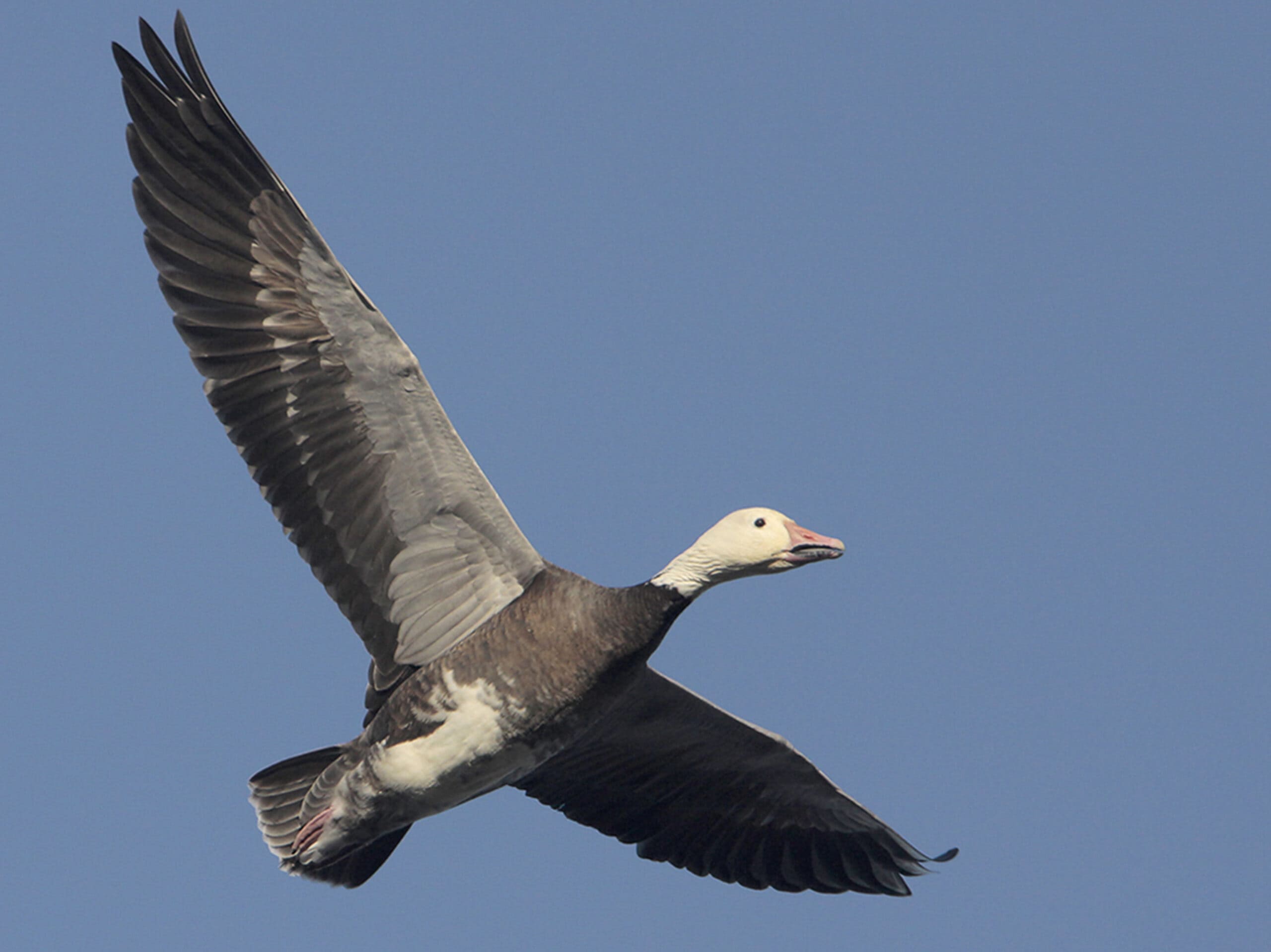
Blue Goose color phase of the Snow Goose. Photograph © Greg Lavaty.
Snow Goose – Snow Geese have a white and a blue adult morph.
The one similar to an adult Emperor Goose is the adult blue morph, and you can almost say it’s the same bird.
However, the Snow Goose has a white stomach instead of a uniformly bluish-gray plumage, a larger bill, and its legs are pink, not orange.
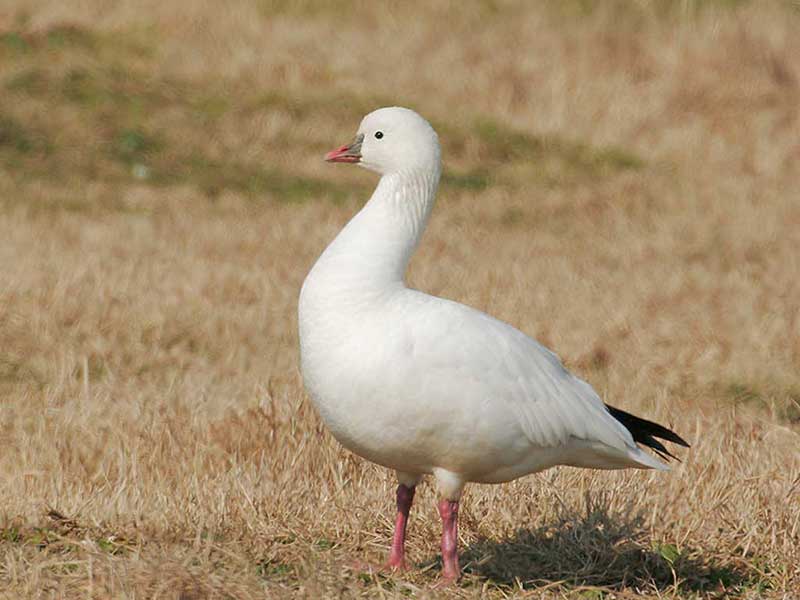
Ross’s Goose. Photograph © Tom Grey
Ross’s Goose – Ross’s Goose also has a white and a blue morph.
However, Ross’s Goose is smaller, the back of its neck is black, not white and it has white not black under-tail coverts.
In addition, Ross’s Goose doesn’t usually appear in the range Emperor Goose occurs in.
FAQ
Is the Emperor Goose endangered?
Emperor Goose is listed as near threatened in the IUCN Red List because its population is in a moderately rapid decline that is expected to continue in the future. This is caused by hunting, coastal oil pollution, and climate change.
Where are Emperor Geese found?
Emperor Geese can be found along Alaska’s shoreline, near coastal lagoons and inland lakes. They are often seen near the Bering Sea but also in northeastern Russia and parts of Canada.

